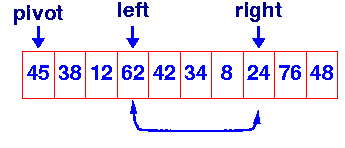Quick Sort: Partition in place
Most implementations of quick sort make use of the fact that you can partition in place by keeping two pointers: one moving in from the left and a second moving in from the right. They are moved towards the centre until the left pointer finds an element greater than the pivot and the right one finds an element less than the pivot. These two elements are then swapped. The pointers are then moved inward again until they "cross over". The pivot is then swapped into the slot to which the right pointer points and the partition is complete.
Note that this above code does not check that left
does not exceed the array bound.
You need to add this check, before performing the
swaps - both the one in the loop and the final one outside the loop.
partition ensures that all items less than the pivot precede it and returns the position of the pivot.
This meets our condition for dividing the problem:
all the items in the lower half are known to be less than the pivot and
all items in the upper half are known to be greater than it.
Note that we have used our ItemCmp function in the partition function. This assumes that there is an external declaration for ItemCmp and that in any one program, we only want to sort one type of object. Generally this will not be acceptable, so the formal specification for quicksort in the Unix and ANSI C libraries includes a function compar which is supplied to qsort when it is called. Passing the function, compar, which defines the ordering of objects when qsort is called avoids this problem in the same way that we passed an ItemCmp function to ConsCollection
However, we have made an unjustified assumption - see if you can identify it before you continue.http://imraan-prrec.blogspot.in/2015/10/quick.html
Most implementations of quick sort make use of the fact that you can partition in place by keeping two pointers: one moving in from the left and a second moving in from the right. They are moved towards the centre until the left pointer finds an element greater than the pivot and the right one finds an element less than the pivot. These two elements are then swapped. The pointers are then moved inward again until they "cross over". The pivot is then swapped into the slot to which the right pointer points and the partition is complete.
int partition( void *a, int low, int high )
{
int left, right;
void *pivot_item;
pivot_item = a[low];
pivot = left = low;
right = high;
while ( left < right ) {
/* Move left while item < pivot */
while( a[left] <= pivot_item ) left++;
/* Move right while item > pivot */
while( a[right] > pivot_item ) right--;
if ( left < right ) SWAP(a,left,right);
}
/* right is final position for the pivot */
a[low] = a[right];
a[right] = pivot_item;
return right;
}
|
 |
Note that we have used our ItemCmp function in the partition function. This assumes that there is an external declaration for ItemCmp and that in any one program, we only want to sort one type of object. Generally this will not be acceptable, so the formal specification for quicksort in the Unix and ANSI C libraries includes a function compar which is supplied to qsort when it is called. Passing the function, compar, which defines the ordering of objects when qsort is called avoids this problem in the same way that we passed an ItemCmp function to ConsCollection
Analysis
The partition routine examines every item in the array at most once, so it is clearly O(n). Usually, the partition routine will divide the problem into two roughly equal sized partitions. We know that we can divide n items in half log2n times. This makes quicksort a O(nlogn) algorithm - equivalent to heapsort.However, we have made an unjustified assumption - see if you can identify it before you continue.http://imraan-prrec.blogspot.in/2015/10/quick.html

No comments:
Post a Comment